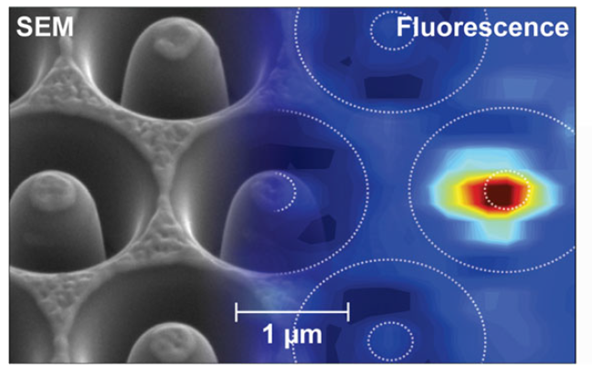Research
Research topics
Our research topics currently are optical spectroscopy and quantum optics with color centers in diamond, quantum photonics with microcavities in diamond and nonlinear optics with single photons. Our goal is to make available color centers in diamond and single photons for applications in quantum technologies.
We investigate single color centers in diamond which are produced by two different methods:
- in-situ incorporation of dopant atoms during diamond growth (CVD method)
- ion implantation in high purity diamond
We are mainly interested in impurity-vacancy centers with group-IV atoms. e.g. silicon- or tin-vacancy centers (SiV, SnV), which provide an optimal combination of optical and spin properties. Furthermore, we are working with the well-known nitrogen-vacancy center (NV) for applications in the field of quantum sensing.
Our major goals are isolation of single color centers, spectroscopic investigation for exploring their structure and identification of color centers with spectral properties which are suitable for quantum optics experiments. An application within the field of quantum information is to realize non-classical light sources with deterministic emission of single photons. Moreover, we investigate the spin properties of these defect centers with view to realization of spin-photon interfaces for quantum networks.
An important method for enhancing the efficiency as well as spatial and spectral properties of single photon emitters is coupling of the emitters to optical cavities. In order to strongly influence the emitter's properties it is mandatory to keep the cavity volume extremely small, i.e. on the order of the emission wavelength.
We follow two approaches:
- coupling of NV centers in nanodiamonds to fiber-based microcavities
- fabrication of microcavities based on photonic crystals in diamond
For realization of fiber-based microcavities we produce micro mirrors by laser machining the front facet of a glass fiber, yielding very small diameter mirrors (~ 30 µm) with very strong radii of curvature. Diamond nanocrystals containing NV centers are spin coated onto a plane mirror, realizing a linear cavity of few micron length. We observe emission of single NV centers into modes of the fiber cavity.
Photonic crystals in diamond are produced from single crystal diamond films by ion etching (focused ion beam milling, reactive ion etching). Microcavities in diamond photonic crystals yield cavity Q-factors > 8000 in the visible spectral range and small mode volumes . We demonstrate coupling to and enhanced emission of single defect centers (SiV, NV) into such cavities as well as cavity-enhanced spin measurements.
Almost all single photon sources realized today emit light within the red or near-infrared spectral region between ca. 600 nm and 1000 nm. Owing to strong absorption in fiber transmission these photons are not well suited for quantum communication over large distances. For the development of long-range quantum networks it is thus very important to realize single photon sources in the wavelength range of telecommunications (1310 nm, 1550 nm). A similar reasoning holds for the investigation of quantum repeater schemes: on one hand quantum information may be stored in long lived electronic states of atoms or ions or spin states of color centers (with read/write operations on optical transitions in the VIS-NIR range) but on the other hand transfer of quantum information is facilitated using photons within the telecom windows.
For realization of these goals we investigate quantum frequency conversion of single photons from the red / infra-red (ca. 600 - 900 nm) spectral region to the telecom bands (1310, 1550 nm) . The method employed here is nonlinear optical difference frequency mixing of single photons with an intense mixing wave resulting in the generation of a single (idler-) photon at telecom wavelengths. Our recent experiments demonstrate highly efficient conversion of single photons, conservation of classical (line shape, coherence) and non-classical (photon statistics, entanglement, indistinguishability) properties as well as employing quantum frequency conversion to enable experiments towards quantum networks (e.g. spin-telecom-photon entanglement).
-
-
Publications
more Publications
-
Research networks
more Research networks
-




















